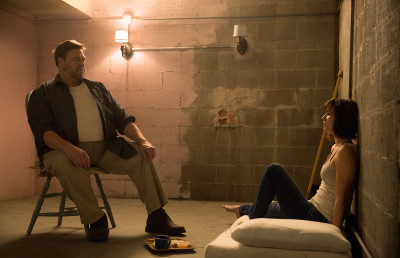
John Goodman as Howard; Mary Elizabeth Winstead as Michelle in 10 CLOVERFIELD LANE; by Paramount Pictures
Now this is how you start a career as a filmmaker!
For most of its 103 minutes, 10 Cloverfield Lane is set in a doomsday bunker with three characters – and before you know it, BAM! The movie is over and you’re thinking ‘what just happened?’ – in the best possible way.
First-time feature director Dan Trachtenberg – from a script by first-timers Josh Campbell and Matthew Stuecken (with a polish by Damien Chazelle, Whiplash) tears through genres like tissue paper but does it the old-fashioned way: with a great script, appropriate direction, fine performances, tight editing and a beautifully timed score.
The film opens on Michelle (Mary Elizabeth Winstead, Scott Pilgrim vs. The World) packing a few things and taking a phone call from Ben. We can’t hear their conversation, but it’s not good because she hangs up on him and ignores him when he calls back. When she leaves the apartment, there’s an engagement ring on a table.
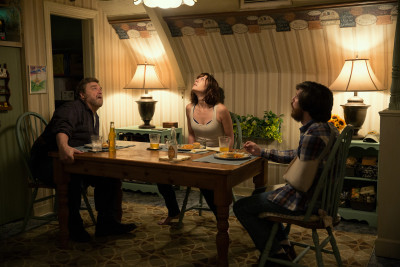
(L-R) John Goodman as Howard, Mary Elizabeth Winstead as Michelle, and John Gallagher Jr. as Emmett in 10 CLOVERFIELD LANE, by Paramount Pictures
As Michelle leaves the city, Ben (voiced by Bradley Cooper) calls again. This time we hear the conversation and it’s just as not good as we’d figured. Something Ben says, though, sticks with us – that Michelle always runs away from trouble.
Then her car is run off the road over some brilliantly designed opening credits.
Michelle wakes up on a mattress in what looks like a basement storage room – with an IV drip, a bandaged up left knee and a pair of handcuffs holding her on the mattress.
Enter Howard (John Goodman, Inside Llewyn Davis, Trumbo), with a tray of food. He claims to have saved her life – after seeing her overturned car – by bringing her to his underground bunker. It seems there’s been an attack – a big one. He thinks it could be the Russians, the Chinese, or Martians. Before he leaves the room (which has a big, honkin’ door that locks from the outside), she frees herself from the cuffs and begins planning her escape.
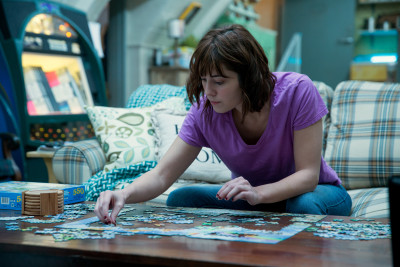
Mary Elizabeth Winstead as Michelle in 10 CLOVERFIELD LANE; by Paramount Pictures
On the other side of the door are a large number of shelves filled with food – possibly a couple years’ worth – and another mattress, on which we find Emmett (John Gallagher Jr., The Newsroom). He seems to be a genial, not too bright young man. He backs up Howard’s story about the attack.
The rest of the bunker is a fully equipped apartment – appliances, TV and video library (DVDs and VHS), livingroom and kitchen furniture and a private bedroom for Howard (which also holds the bathroom, such as it is).
As we watch, we can the wheels turning behind Michelle’s eyes. She makes a break for it after lifting Howard’s keys, but sees something that makes her think Howard might be right – though she’s taking nothing for granted.
For about ninety minutes, Trachtenberg and his cast explore these three characters.
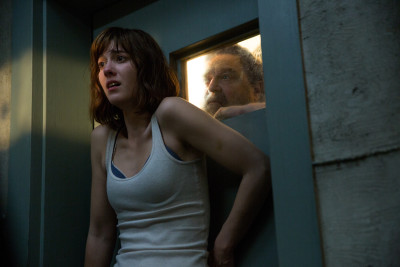
John Goodman as Howard; Mary Elizabeth Winstead as Michelle in 10 CLOVERFIELD LANE; by Paramount Pictures
Howard is something of a puzzle – genial enough at times, but with a ferocious temper and a serious side of paranoia. Emmett is pretty much who we saw when we met him – but he tries to be supportive when Michelle gets on Howard’s nerves, so he’s definitely a decent guy.
Michelle, though, is something that matches well against Howard – smart, observant and always planning.
Goodman and Winstead give the performances of their careers – and Gallagher is not that far behind.
The bunker is cozy enough that the tensions that rise between the characters are felt that much more by the audience. A simple board game or a Trivial Pursuit-like game can seem like life or death – all because of the shadings in the cast’s performance and the use of the score (and some really fine editing…).
At first, the bunker is shot to seem fairly roomy, but as the film progresses and tensions mount, it seems to shrink. And, in a nice bit of writing, almost every humorous moment is following by a rise in tension. Trachtenberg teases us with details, too – as when Michelle and Emmett discover something creepy.
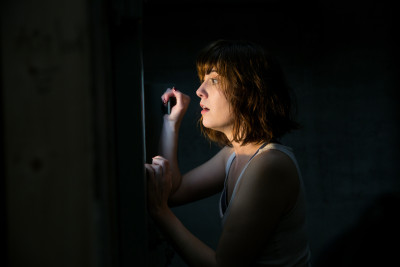
Mary Elizabeth Winstead as Michelle in 10 CLOVERFIELD LANE; by Paramount Pictures
Then there are details that seem just a bit off – like the ventilation system, and a second window that makes Michelle reconsider her reconsideration of Howard’s story.
Even when things seem to be reaching an end point, there are twists and turns that we never see coming, but feel just right all the same. Every frame of 10 Cloverfield Lane matters, too. There are no wasted shots here.
Producer J.J. Abrams has described 10 Cloverfield Lane as a ‘spiritual sequel’ to Cloverfield. Though it’s not a kaiju movie, 10 has the same kind of fierce intelligence and wit that made Cloverfield an unexpected delight. It also has the same capacity to surprise – a good trick in a film in which most the action takes place in a doomsday bunker.
Further evidence of 10 Cloverfield Lane’s excellence: I had more than half of my big drink left when the closing credits began to roll. I can’t wait to see what Trachtenberg, Campbell and Stuecken come up next – this is one heckuva calling card!
Final Grade: A+